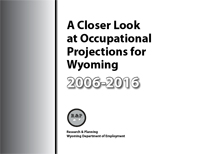Frequently Used Terms and Acronyms
Average annual wage: Total payroll for the year divided by average employment for the year.
Classification of Instructional Programs (CIP): A standardized method of classifying postsecondary educational programs. More information about CIP is available from the U.S. Department of Education at http://nces.ed.gov/pubsearch/pubsinfo.asp?pubid=2002165.
Federal poverty guideline: Sometimes referred to as the poverty line, the federal poverty guideline is established by the U.S. Department of Health and Human Services (http://aspe.hhs.gov/poverty/08poverty.shtml) as the baseline income required for families or households of varying sizes. This publication uses the 2008 federal poverty guideline of $21,200 for a family of four.
Major occupational group: A two-digit occupation from the Standard Occupational Classification (SOC) that groups common occupations; the highest level of aggregation in the SOC.
North American Industry Classification System (NAICS): The lowest level of aggregation is a six-digit NAICS code; the highest aggregation level is a supersector (see below). Further information is available from the U.S. Census Bureau website at http://www.census.gov/eos/www/naics/faqs/faqs.html.
Occupational Employment Statistics (OES): A survey program conducted by the U.S. Department of Labor, Bureau of Labor Statistics. Wage and employment statistics are produced for more than 800 occupations for geographic areas including the U.S. and the 50 states. Data from OES are used to develop occupational projections. Minimum education level and wages, which are also included in the OES data set, are used to expand the projections’ usefulness. More information about the OES program is available at http://www.bls.gov/oes.
Replacement: Refers to the demand for workers created by retirement or other withdrawals from the labor market.
Residual occupation: A detailed category to which occupations not elsewhere classified within a major occupational group are assigned.
Sector: An aggregation of North American Industry Classification System code at the two-digit level.
Standard Occupational Classification (SOC): A standardized method for classifying occupations. Occupations are classified from two to six digits, with six digits being the most detailed. More information is available at http://stats.bls.gov/soc/socguide.htm.
Subsector: An aggregation of North American Industry Classification System codes at the three-digit level.
Supersector: An aggregation of North American Industry Classification System sector codes. More information about BLS standards for sector aggregation is available at http://stats.bls.gov/bls/naics_aggregation.htm.
Total payroll: The sum of all wages paid to Unemployment Insurance-covered full- and part-time employees. More information about total payroll is available at http://doe.state.wy.us/LMI/01202pub/intro.htm#glos.

